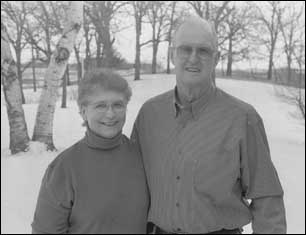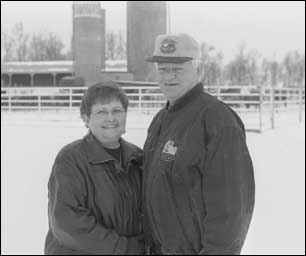 Algene and Carol Otteson
Algene and Carol Otteson
Algene and Carol Otteson have traded their 40-cow dairy operation and 187-acre farming operation for 160 acres of restored prairie in the Conservation Reserve Program (CRP) and 15 head of beef cows.
Algene and Carol Otteson of Irving Township and David and Jan Brinkman of Paynesville Township were named Outstanding Conservation Operators by their respective Soil and Water Conservation Districts (SWCD) in Kandiyohi and Stearns counties.
The Ottesons have retired from their dairy operation and are returning their farmland to prairie, woods, and wildlife habitat. The Brinkmans have used conservation practices for nearly 20 years to operate a 1,000-acre, 300-steer beef operation.
The awards are sponsored by The Farmer, and both Paynesville couples were recognized at a noon luncheon on Tuesday, Dec. 5, with the winners from 72 counties across the state. The awards ceremony was part of a three-day conference for SWCD board members and employees at the Radisson South in Bloomington.
 Algene and Carol Otteson
Algene and Carol Otteson
Algene and Carol Otteson have traded their 40-cow dairy operation and 187-acre farming operation for 160 acres of restored prairie in the Conservation Reserve Program (CRP) and 15 head of beef cows.
After nearly 30 years of having dairy cows, the Ottesons gave up milking three years ago. They gave CRP a try a year later, in 1998, with the entry of 78 acres. They put another 82 acres into CRP in 1999, leaving only a 27-acre tillable field on their farm.
"I think it's worthwhile," said Algene of the government program. "It's good for the land, it's good for the wildlife, and it's good to get land out of production."
Both Algene and Carol grew up in Irving Township, just a few miles west of the farmstead where they have lived since 1956. They can laugh about it now, but in returning their farm to prairie they are just following unheeded advice from 40 years ago.
When they first bought the farm, they ditched to get more land in production and cleared up a building site in the woods. While they were doing this nearly a half century ago, a neighbor lamented the destruction of the trees. "We realize now how important that was," said Carol.
The Ottesons planted three-and-a-half-acre plots of trees in 1998 and again in 1999. This year they planted over 2,000 trees to be a living snow fence. The two rows, over 1,000 feet, are meant to protect the township road to the east of the farm.
"Really, when you plant trees in a sense you're preserving the land," said Algene. Preserving the land for future generations is more important to the Ottesons these days. Even if the farm is removed from CRP in ten years, the Ottesons think the land at least would be more productive after laying idle for a decade.
"I think preservation for their family is their ethic," said Rick Reimer, program coordinator for the Kandiyohi County SWCD. "They've worked the land and now they're letting it rest."
Algene enjoys tending his prairie, preferring cutting thistles and planting trees to gardening or lawn care. Farming CRP can be done without the newest technology, with the machinery that the Ottesons have used for years on their farm.
"Just so I have something," said Algene. "...to play with," added Carol.
The Ottesons also allowed the U.S. Fish and Wildlife Service to restore a slough on their land this past year. "Last year there was no water so it was easy to do it, said Algene. "All we did was give the OK and they did all the work."
The Ottesons said they were surprised and honored to win the award.
 David and Jan Brinkman
David and Jan Brinkman
David and Jan Brinkman manage 1,000 acres and 300 head of cattle for the Kocka Limited Partnership, owned by the Lloyd Peterson family.
He started using conservation practices in the operation of the farm in 1983, using a chisel plow to mulch till his corn and soybeans. Three years later, he went a step further with no-tilling of much of the cropland.
Brinkman was motivated to try these plowing techniques by the conditions in his fields. "You hate to see washouts and gullies in the field," he explained. "We knew we had to do something about it."
He used to find three- to four-foot gullies in his fields from erosion. "If the wind blows a side off your building you're going to repair it. If the wind blows your soil off are you just going to let it blow?" he asked.
By not tilling, by planting corn in soybean stubble and leaving residue in the fields in the fall, the impact of wind erosion in the winter and water erosion in the spring is limited.
Time and fuel are saved by not tilling. Brinkman says no-till farming is "recreational tillage."
"It all comes down to the bottom line," said Brad Wenz, a soil conservationist with Stearns County SWCD. "The cost per unit produced is lower for minimum tillage."
"Dave was one of the first no-tillers in Stearns County, one of the early pioneers in that practice," Wenz added. "It takes a pretty good operator to consistently have success with no-till."
To further control gully erosion, one sediment basin was constructed in 1988 and eight more in 1990.
Run-off mitigation began in 1988 with the installation of 1.5 acres of grass waterways. The farm now has 108 acres enrolled in CRP, with 50 acres dedicated to 100'-wide filter strips surrounding the 40 wetlands restored by the U.S. Fish and Wildlife Service. Forty-five acres are enrolled in the federal waterbank program.
The key to run-off mitigation is a concrete stacking slab and earthen basin built five years ago. The 82' by 237' slab can hold 1,800 tons of manure. The clay-lined basin can hold over 800,000 gallons of waste.
The system was designed to stop manure run off from flowing into the north fork of the Crow River. It also holds all the manure for use as fertilizer on the farm. Brinkman uses no commercial fertilizer on nearly 150 acres of land.
"The whole concept is just being a good steward of the land," said Jan.
The Brinkmans learned they had won the award in August. "I was a little surprised," said David, "and I guess a little proud that the work we did received recognition. There are a lot of good farmers in the county."
Unfortunately, Lloyd Peterson, the managing partner in the farm, passed on in August. The Brinkmans said Lloyd was supportive of conservation efforts and a mentor in stewardship. David said Lloyd often stressed the importance of taking care of the soil because he wanted to pass on a farm, not just worn-out ground.
The Brinkmans attended the three-day conference and appreciated learning about the conservation practices that other people are using. Conservation winners from 72 counties were recognized.
David said he plans on maintaining the conservation practices on the farm "until they come out with some better ones. I'm always open to suggestions."